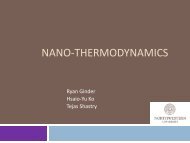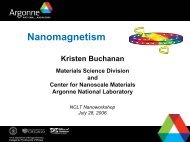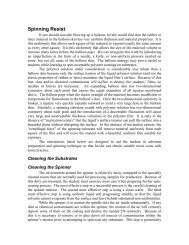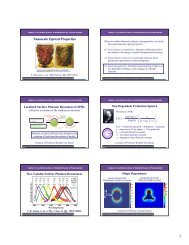A Practical Guide to SPM
A Practical Guide to SPM
A Practical Guide to SPM
Create successful ePaper yourself
Turn your PDF publications into a flip-book with our unique Google optimized e-Paper software.
24<br />
VIII. Probes<br />
AFM Probes<br />
The next three sections discuss various probe characteristics and types.<br />
Silicon Nitride<br />
Silicon nitride probes consist of a cantilever integrated with a sharp tip<br />
on the end. The properties and dimensions of the cantilever play an<br />
important role in determining the sensitivity and resolution of the AFM.<br />
0.12<br />
0.32<br />
0.58<br />
0.06<br />
Four silicon nitride cantilevers showing<br />
spring constants (N/m) a *<br />
Figure 8-1. Image of silicon nitride probe.<br />
For contact mode AFM imaging, it is necessary <strong>to</strong> have a cantilever<br />
that is soft enough <strong>to</strong> be deflected by very small forces (i.e., small force<br />
constant) and has a high enough resonant frequency <strong>to</strong> not be<br />
susceptible <strong>to</strong> vibrational instabilities. This is accomplished by making<br />
the cantilever short (<strong>to</strong> provide a high resonant frequency) and thin (<strong>to</strong><br />
provide a small force constant).<br />
For the silicon nitride tips, there are four cantilevers with different<br />
geometries attached <strong>to</strong> each substrate, resulting in four different spring<br />
constants (Figure 8-1).<br />
Characteristics of the standard silicon nitride probes (Models NP and<br />
DNP) are listed in Table 8-1.<br />
Spring constant (k) 0.58, 0.32, 0.12, 0.06 N/m *<br />
Nominal tip radius of curvature 20–60nm<br />
Cantilever lengths 100 and 200µm<br />
Cantilever configuration V-shaped<br />
Reflective coating<br />
Gold<br />
Sidewall angles<br />
35° on all four sides<br />
Table 8-1. Silicon nitride probe characteristics.<br />
Silicon<br />
Silicon probes are used primarily for TappingMode applications. The<br />
tip and cantilever are an integrated assembly of single-crystal silicon<br />
produced by etching techniques. Only one cantilever and tip are<br />
integrated with each substrate. These probes (Figure 8-2) can be<br />
much stiffer than silicon nitride probes, resulting in larger force<br />
constants and resonant frequencies.<br />
Figure 8-2. Scanned electron microscope (SEM) images of<br />
silicon cantilever and tip.<br />
* Calculated spring constant values are based on the 0.6µm<br />
silicon nitride thickness; however, this value can actually vary from<br />
0.4µm–0.7µm. Thickness is cubed in the spring constant<br />
calculation; thus, actual values can vary substantially.<br />
Characteristics of the TappingMode Etched Silicon Probe (Model<br />
TESP) are listed in Table 8-2.<br />
Spring constant (k)<br />
20–100 N/m<br />
Resonant frequency<br />
200–400 kHz<br />
Nominal tip radius of curvature 5–10nm<br />
Cantilever length 125µm<br />
Cantilever configuration Single beam<br />
Reflective coating<br />
Uncoated, optional Al coating<br />
Table 8-2. TappingMode Etched Silicon Probe (TESP) characteristics.
















